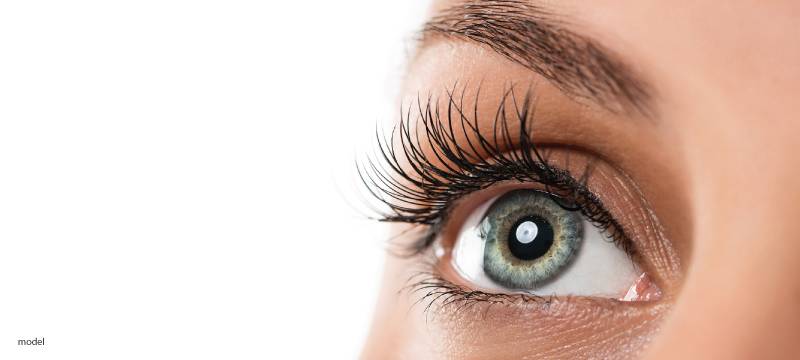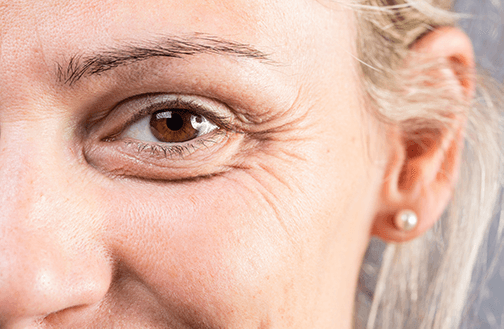Crow’s Feet Treatment And Prevention Options

Originally published October 20, 2020. Updated on June 26, 2025
Crow’s feet are wrinkles at the corner of the eyes that branch out into the shape of, you guessed it, crow’s feet. These wrinkles develop as we age thanks to years of facial muscle contractions. Because the skin around our eyes is up to 40% thinner than the rest of our body, crow’s feet often develop far sooner than other facial wrinkles and are among the first signs of aging.
There are two types of crow’s feet, static and dynamic. Static crow’s feet are constantly visible, even when the facial muscles are relaxed. Some facial expressions can make static crow’s feet appear even deeper and more severe. In contrast, dynamic crow’s feet are those that appear only when the muscles around the eyes, cheeks or temples contract. This form of crow’s feet is not apparent when the face is at rest.
What Are Crow’s Feet?
Crow’s feet, technically called orbicularis oculi contractions (but sometimes also referred to as laugh lines or character lines), are clusters of wrinkles and lines that spread out from the outer corners of the eyes. At times these wrinkles can look like foot prints from a crow, hence the name.
Crow’s feet are an inevitable sign of facial aging that typically begin to form as tiny lines in a person’s mid-twenties. Over time, these fine lines begin to deepen into more pronounced wrinkles or folds that are visible even when a person is expressionless.

An example of crow’s feet
What Causes Crow’s Feet?
Crow’s feet are a natural result of aging. As we age, our skin becomes thinner and the skin’s level of collagen and elastin production decreases:
Collagen is a protein that contributes to the plump, youthful look of our skin. Without this protein scaffolding, skin sags, appears thinner, and wrinkles become deeper.
Elastin contributes to the skin’s ability to recover from being stretched or compressed. As elastin production declines, wrinkles develop.
Decreased levels of these proteins make the skin more susceptible to sagginess and the development of lines and wrinkles. In addition to aging, lifestyle and environmental factors such as sun exposure, pollutants, lack of hydration or inadequate nutrition can all contribute to a loss of collagen and elastin.
Crow’s feet are typically one of the first signs of facial aging that occur, as they can begin to become visible at an early age (often mid-20’s). The reason for such an early development is due to the thin and delicate nature of the skin around the eyes, which experiences the loss of elasticity faster than surrounding skin.
Crow’s feet are considered expression wrinkles as they form after years of facial muscle contractions while performing various everyday facial expressions like smiling, squinting, or frowning. During our younger years when the skin has more elasticity, crow’s feet often only appear while during the actual muscle contraction. This is because the skin is better able to “snap back” into its proper place once the contractions ceases.
With natural aging, however, the skin begins to lose its elasticity resulting in the static appearance of crow’s feet. The decline in collagen and other skin proteins also makes crow’s feet lines appear deeper and more prominent.
Preventing Crow’s Feet
Unfortunately, there is no way to fully prevent crow’s feet. Nearly everyone will get crow’s feet at some point in their lifetime. However, measures can be taken to reduce both the severity and depth of crow’s feet. Effective measures to prevent crow’s feet include:
- Limit Sun Exposure: UV light is damaging to both collagen and elastin. Limit time in the sun, and avoid tanning beds completely. If you must be outdoors for extended periods of time, wear protection.
- Avoid Smoking: Smoke and other air pollutants speed up the aging process by damaging collagen and elastin. This causes premature skin sagging and wrinkles.
- Eat Healthy: Collagen requires amino acids, vitamin C, and minerals such as zinc and sulfur. Eating healthy meals with a variety of fruits and vegetables provides these nutrients.
- Exercise: Movement increases the heart rate, circulates blood and nutrients, and keeps skin oxygenated. This increases collagen production for a glowing, youthful look.
- Moisturize: Eye creams and moisturizers with retinol, vitamin C or hyaluronic acid help plump skin by stimulating collagen production, which reduces the appearance of wrinkles and fine lines.
- Skin Care Regimen: Keep your skin looking and feeling its best by following a sound daily skin care regimen. We encourage patients to properly cleanse the skin, use a daily moisturizer, and regularly exfoliate the skin.
- Sunglasses: Wearing polarized sunglasses can protect the delicate skin around the eyes and prevent excessive squinting.
Treating Crow’s Feet
Crow’s feet are not harmful but may be aesthetically unpleasing. Patients who have developed crow’s feet can choose from a variety of treatment options to limit their visible appearance. The best treatment for each patient will depend on the severity of their crow’s feet and well as their desired outcome. Additionally, patients may benefit from trying a combination of various treatments.
Topical Skin Care Products
There are many topical products, either over-the-counter or prescription strength, that are very good at addressing fine lines and moderate wrinkles. Some of the best options include eye creams and serums formulated with ingredients like retinol, hyaluronic acid, and vitamin C. These products work by removing dead skin, encouraging new skin cell development, and protecting the skin from further aging. As always, it’s best to consult with your dermatologist before introducing any new skin care product into your regimen.
Botox
Botox smooths wrinkles that result from repetitive muscle constriction by paralyzing the muscles that form the wrinkles. This safe and effective treatment is temporary, but very effective in those between the ages of 30-50 whose wrinkles are just beginning to appear. Treatments last anywhere from 3-6 months and additional period maintenance sessions can maintain results over a longer period.
Dermal Fillers
Dermal fillers are effective for static crow’s feet, those that appear even when the face is relaxed. Dermal fillers plump the skin making wrinkles less visible. Some dermal fillers work by provoking an increase in the body’s own collagen production. Dermal fillers last 3-12 months or longer, depending upon the type used.
Chemical Peels
Chemical peels work by removing the outer layer of skin, triggering a healing process. The skin that grows back is newer, younger and smoother. Wrinkles are diminished with a deep chemical peel, although the procedure can also be done at medium and light depths. Chemical peels last 1 month to several years, depending upon the depth of the peel.
Laser Skin Resurfacing
Laser skin resurfacing works similarly to a chemical peel, but is more precise. The upper layers of skin are removed, which reveals younger looking skin. New skin has more collagen and elastin, making it less susceptible to wrinkles. The effects of laser resurfacing last for many years
Microneedling
Microneedling uses a hand-held device to create tiny punctures in the skin. This triggers the release of growth hormones that increase collagen production. As the skin heals, it becomes more youthful and elastic. Microneedling results typically last for approximately 4-6 weeks after treatment.
Each of the above treatment options will reduce the appearance of crow’s feet. The best treatment for each patient depends several factors including the severity of their crow’s feet, patient age, and skin type. Seeing a Board Certified Dermatologist for an in-person consultation is the best way to find out which treatment will work for your specific needs.
Disclaimer: The contents of the Westlake Dermatology website, including text, graphics, and images, are for informational purposes only and are not intended to substitute for direct medical advice from your physician or other qualified professional.
